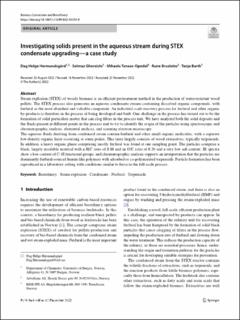| dc.contributor.author | Hermundsgård, Dag Helge | |
| dc.contributor.author | Ghoreishi, Solmaz | |
| dc.contributor.author | Opedal, Mihaela Tanase | |
| dc.contributor.author | Brusletto, Rune | |
| dc.contributor.author | Barth, Tanja | |
| dc.date.accessioned | 2023-01-23T14:02:53Z | |
| dc.date.available | 2023-01-23T14:02:53Z | |
| dc.date.created | 2022-12-19T09:37:09Z | |
| dc.date.issued | 2022 | |
| dc.identifier.issn | 2190-6815 | |
| dc.identifier.uri | https://hdl.handle.net/11250/3045420 | |
| dc.description.abstract | Steam explosion (STEX) of woody biomass is an efficient pretreatment method in the production of water-resistant wood pellets. The STEX process also generates an aqueous condensate stream containing dissolved organic compounds, with furfural as the most abundant and valuable component. An industrial-scale recovery process for furfural and other organic by-products is therefore in the process of being developed and built. One challenge in the process has turned out to be the formation of solid particulate matter that can clog filters in the process unit. We have analyzed both the solid deposits and the fluids present at different points in the process unit to try to identify the origin of the particles using spectroscopic and chromatographic analysis, elemental analysis, and scanning electron microscopy.
The aqueous fluids deriving from condensed steam contain furfural and other small organic molecules, with a separate low-density organic layer occurring at some points. This layer largely consists of wood extractives, typically terpenoids. In addition, a heavy organic phase comprising mostly furfural was found at one sampling point. The particles comprise a black, largely insoluble material with a H/C ratio of 0.88 and an O/C ratio of 0.26 and a very low ash content. IR spectra show a low content of C–H functional groups, and chromatographic analysis supports an interpretation that the particles are dominantly furfural-sourced humin-like polymers with adsorbed or co-polymerized terpenoids. Particle formation has been reproduced in a laboratory setting with conditions similar to those in the full-scale process. | en_US |
| dc.language.iso | eng | en_US |
| dc.publisher | Springer | en_US |
| dc.rights | Navngivelse 4.0 Internasjonal | * |
| dc.rights.uri | http://creativecommons.org/licenses/by/4.0/deed.no | * |
| dc.title | Investigating solids present in the aqueous stream during STEX condensate upgrading—a case study | en_US |
| dc.type | Journal article | en_US |
| dc.type | Peer reviewed | en_US |
| dc.description.version | publishedVersion | en_US |
| dc.rights.holder | Copyright 2022 the authors | en_US |
| cristin.ispublished | true | |
| cristin.fulltext | original | |
| cristin.qualitycode | 1 | |
| dc.identifier.doi | 10.1007/s13399-022-03593-9 | |
| dc.identifier.cristin | 2094973 | |
| dc.source.journal | Biomass Conversion and Biorefinery | en_US |
| dc.identifier.citation | Biomass Conversion and Biorefinery. 2022. | en_US |

